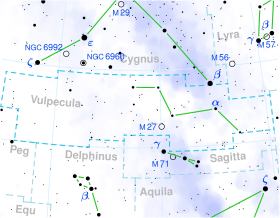Top Qs
Timeline
Chat
Perspective
31 Vulpeculae
Star in the constellation Vulpecula From Wikipedia, the free encyclopedia
Remove ads
31 Vulpeculae is a binary star[8] system in the northern constellation of Vulpecula. It is visible to the naked eye as a faint, yellow-hued point of light with an apparent visual magnitude of 4.56.[2] The system is located approximately 228 light years away from the Sun based on parallax,[1] and it is drifting further away with a radial velocity of +2.25 km/s.[6]
The variable radial velocity of this system was first suspected by German Astronomer Friedrich Küstner in 1914. The system appears as a single-lined spectroscopic binary with an orbital period of 5.1 years and an eccentricity of 0.38. The a sin i value for the primary is 103.0 ± 1.1 Gm (0.69 ± 0.01 AU),[8] where a is the semimajor axis and i is the (unknown) orbital inclination. This value provides a lower bound on the actual semimajor axis for the orbit.
The primary component is an aging giant star with a stellar classification of G7IIIa Fe-1 Ba,[2] indicating a mild barium star with an underabundance of iron.[8] Having exhausted the supply of hydrogen at its core, it has expanded to eight times the Sun's radius.[9] It is a red clump giant,[3] which indicates it is on the horizontal branch and is generating energy through helium fusion at its core. This is a suspected variable star with a magnitude that varies from 3.77 to 4.08 in the I passband.[5] It is about 700 million years old with 2.4 times the mass of the Sun. The star is radiating 53[2] times the luminosity of the Sun from its enlarged photosphere at an effective temperature of 5,261 K.[9] The companion may be a degenerate white dwarf with about 0.4 M☉.[8]
Remove ads
References
External links
Wikiwand - on
Seamless Wikipedia browsing. On steroids.
Remove ads

